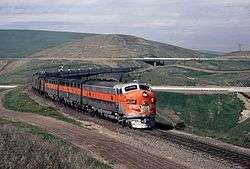Western Pacific Railroad
 | |
|
c. 1914 Map of the Western Pacific and Denver and Rio Grande Western systems. | |
|
| |
| Reporting mark | WP |
|---|---|
| Locale | Western United States |
| Dates of operation | 1903–1983 |
| Successor | Union Pacific Railroad |
| Track gauge | 4 ft 8 1⁄2 in (1,435 mm) |
| Headquarters | Oakland, California |
The Western Pacific Railroad (reporting mark WP) was a Class I railroad in the United States. It was formed in 1903 as an attempt to break the near-monopoly the Southern Pacific Railroad had on rail service into northern California. WP's Feather River Route directly competed with SP's portion of the Overland Route for rail traffic between Salt Lake City/Ogden, Utah and Oakland, California for nearly 80 years. In 1983 the Western Pacific was acquired by the Union Pacific Railroad. The Western Pacific was one of the original operators of the California Zephyr.
History
The original Western Pacific Railroad was established in 1865 to build the westernmost portion of the Transcontinental Railroad between San Jose, California (later Oakland, California), and Sacramento, California. This company was absorbed into the Central Pacific Railroad in 1870.
The second company to use the name Western Pacific Railroad was founded in 1903. Under the direction of George Jay Gould I, the Western Pacific was founded to provide a standard gauge track connection to the Pacific Coast for his aspiring Gould transcontinental system. The construction was financed by the Denver and Rio Grande Western Railroad, a company in the Gould system, which lost access to California due to the attempted acquisition of the Southern Pacific Railroad by the Rio Grande's main rival, the Union Pacific Railroad. The Western Pacific Railroad acquired the Alameda and San Joaquin Railroad and began construction on what would become the Feather River Route. In 1909 it became the last major railroad completed into California. It used 85-lb rail on untreated ties, with no tie plates except on curves over one degree; in 1935 more than half of the main line still had its original rail, most of it having carried 150 million gross tons.[1]

In 1931 Western Pacific opened a main line north from the Feather River Canyon to the Great Northern Railway in northern California. This route, the "Highline", joined the Oakland – Salt Lake City main line at the Keddie Wye, a unique combination of two steel trestles and a tunnel forming a triangle of intersecting track. In 1935, the railroad went bankrupt because of decreased freight and passenger traffic caused by the Depression and had to be reorganized.[2]
WP attracted rail enthusiasts from around the world. It operated the California Zephyr passenger train with the Denver and Rio Grande Western Railroad and the Chicago, Burlington and Quincy Railroad. The WP handled the "Silver Lady" from Oakland, California, to Salt Lake City, Utah from 1949–1970. The Western Pacific owned several connecting short-line railroads. The largest was the Sacramento Northern Railway, which once reached from San Francisco to Chico, California. Others included the Tidewater Southern Railway, the Central California Traction, the Indian Valley Railroad and the Deep Creek Railroad. At the end of 1970 WP operated 1,187 miles (1,910 km) of road and 1,980 miles (3,190 km) of track, not including its Sacramento Northern and Tidewater Southern subsidiaries.
The Western Pacific was acquired in 1983 by Union Pacific Corporation, which in 1996 would purchase its long-time rival, the Southern Pacific Railroad. In July 2005 Union Pacific unveiled a brand new EMD SD70ACe locomotive, Union Pacific 1983, painted as an homage to the Western Pacific.
Passenger operations
The California Zephyr was the famous Western Pacific passenger train but the railroad had a few others:
- Exposition Flyer (Chicago to Oakland in conjunction with the Chicago, Burlington and Quincy Railroad and Denver and Rio Grande Western Railroad, 1939 to 1949; named after the Golden Gate International Exposition of 1939 and 1940)
- Royal Gorge (between Oakland and Denver via Pueblo)
- Scenic Limited (between Oakland and Denver via Pueblo)
- Zephyrette (between Oakland and Salt Lake City)
Many special charter passenger trains have used parts of the WP route:
- Feather River Express (between Oakland and Portola, California) Special Charter train for Portola Railroad Days.
- Northern California Explorer (Emeryville, Oroville, Keddie, Westwood, Klamath Falls, Black Butte, Chico, Sacto, Emeryville).
List of presidents
There were twelve presidents of this railroad:[3]
- Walter J. Bartnett (March 3, 1903 to June 23, 1905)
- Edward T. Jeffery (June 23, 1905 to November 6, 1913)
- Benjamin F. Bush (November 6, 1913 to March 4, 1915)
- Charles M. Levey (July 14, 1916 to March 30, 1927)
- Harry M. Adams (March 30, 1927 to December 31, 1931)
- Charles Elsey (January 1, 1932 to December 31, 1948)
- Harry A. Mitchell (January 1, 1949 to July 1, 1949)
- Frederic B. Whitman (July 1, 1949 to June 30, 1965)
- Myron M. Christy (June 30, 1965 to November 30, 1970)
- Alfred E. Perlman (December 1, 1970 to December 31, 1972)
- Robert G. "Mike" Flannery (January 1, 1973 to June 9, 1982)
- Robert C. Marquis (June 9, 1982 to January 11, 1983)
See also
- Hercules (1907) – Ship operated by the Western Pacific
- Western Pacific Railroad Museum
- Western Refrigerator Line – Subsidiary of the Western Pacific
References
- ↑ Railway Age: 309. 31 Aug 1940. Missing or empty
|title=(help) - ↑ DeNevi, Don (1978). The Western Pacific. Superior Publishing. p. 76.
- ↑ March 1983 issue of Mileposts. Western Pacific Railway and Railroad
External links
| Wikimedia Commons has media related to Western Pacific Railroad. |
- Western Pacific Railroad Museum in Portola California
- Western Pacific Railroad Historical Society
- Livermore History – Railroads 1
- WP Subsidiary Tidewater Southern Website
- WP Subsidiary Central California Traction Website

